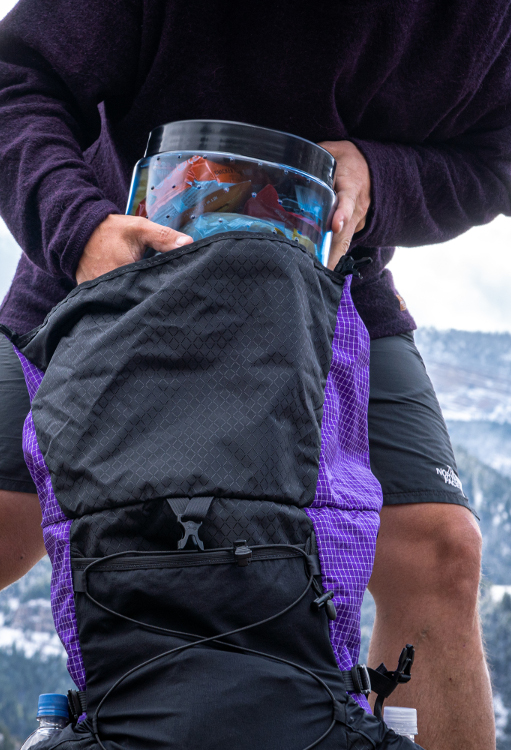
A BEAR VAULT BV450 + ULA CDT BACKPACK
Bears! Everything You Need to Know About Backpacking in Bear Country
WILL MY BEAR CANISTER FIT IN MY ULA PACK?
Whether you’re on a thru-hike or just an overnighter, encountering a bear can be a scary experience. However, with the right knowledge and preparation, you can minimize the risk of a dangerous encounter.
Preparation
Before heading into bear country, it’s important to be prepared. This means bringing the right gear, including bear spray, a means to safely store your food (this will vary depending on your area), and a healthy knowledge of what to do outside of your gear should you encounter a bear.
It’s also important to make note to make noise while you’re hiking or camping in bear country, as bears are more likely to avoid humans if they know you’re coming. This can be as simple as talking or singing while you hike.
Types of Bears
The first step in bear safety is understanding the types of bears you might encounter in the wild. In North America, there are three types of bears: black bears, grizzly bears (also known as brown bears), and polar bears. In most cases you’re most likely to encounter a Grizzly or Black Bear.
Black Bears are the most common type of bear in North America, and they are found in forests and woodlands throughout the continent. Despite their name, black bears can also be brown, cinnamon, or even white in color. These are most prominent along the East Coast and all throughout the Appalachian Trail.
Grizzly Bears are larger and more aggressive than black bears, and they are found in western North America typically on the West Coast throughout sections of the Pacific Crest Trail and in areas like Montana and along Continental Divide Trail. They are typically brown or blonde in color, with a distinct hump on their shoulders.
Encountering a Bear
Depending on the type of bear you encounter, what to do when you find yourself in this situation will vary.
Black Bears:
If you do encounter a bear, it’s important to stay calm and avoid startling the bear. This means speaking in a calm voice while slowly backing away to create distance between you and the bear. Do not turn your back on the bear, and do not run, as this can cause the bear to chase you down. Do not drop your gear and do not try to distract the bear with food.
If the bear charges you, use your bear spray, aiming for the bear’s face. If you experience a charging bear, do not run, continue to try to scare the bear away. If the black bear attacks you, stand and fight. Grab anything at your disposal to fight back including rocks, trekking poles, or branches. Aim for the bear’s eyes and nose, as these are sensitive areas that can help you to fend off the attack.
Grizzly Bears:
If you get charged by a Grizzly Bear, deploy your bear spray aiming for the bear’s face. Unlike a Black Bear, DO NOT FIGHT BACK with a Grizzly. PLAY DEAD by getting into the fetal position with your hands protecting your neck and your pack protecting your back.
Despite the type of bear you encounter, it is important to remember that bears are wild animals and should be treated as such. Always keep a safe distance between you and a bear, do not stop to take pictures or feed bears should you encounter one out in the wild.
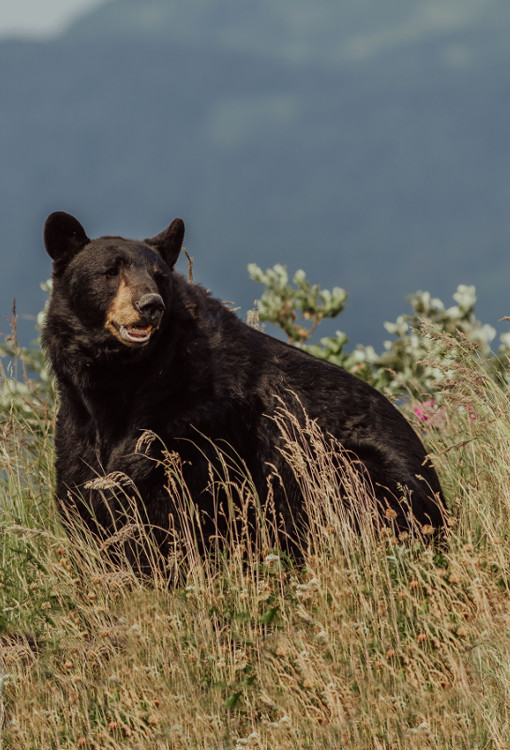
BLACK BEAR (Photo: Danika Perkinson)
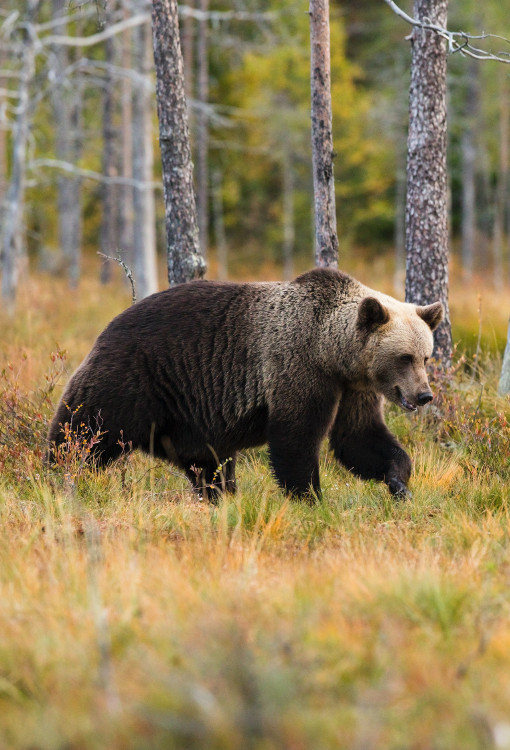
GRIZZLY BEAR (Photo: Zdeněk Macháček)
Gear to safely store your food
When selecting a bear canister, it’s important to consider the size and weight of the canister, the durability of the materials, and the level of protection it offers against bears. Many national parks and wilderness areas have specific requirements for bear canisters, so be sure to check regulations before heading out on your trip. Here are two of the most common types of bear canisters.
- Hard-sided Bear Canisters: Hard-sided canisters are made from durable materials such as polycarbonate or carbon fiber, and they are designed to withstand the strength and persistence of bears. They are typically round or cylindrical in shape and feature a locking lid that requires a special tool to open.
- Soft Bear Bags: Soft-sided canisters are made from lightweight, flexible materials such as ripstop nylon or Cordura, and they are easier to pack and carry than hard-sided canisters. They feature a drawstring closure and may require a separate cord or hanging system to secure them to a tree or other fixed object. An example of this would be the Ursak Major or ULA Bear Bag.
How to store your food:
- When camping in bear country, it’s important to remember to store all of your food and scented items in your bear canister and place it a safe distance from your camp site. A good distance to remember is about 200 – 300 feet from your site. This will help to prevent bears in the area associating campsites and humans with food.
- Along with storing food away from your campsite, cooking your food should be done in a separate location from camp as well. Be sure to designate an area if you find yourself in the same campsite multiple nights in a row.
- Although these rules are great to follow for most times out in the backcountry it’s still important to check the rules and regulations of the wilderness area you find yourself camping in as some places have different rules than others.
FITTING A BEARVAULT INTO A ULA BACKPACK
In this quick video (2:51), Garrett compares the ULA Circuit to the ULA Catalyst and explains how a BearVault fits in each (1:55).
Both the Catalyst and the Circuit can fit food storage bins like the BV500 and under. The Catalyst can fit a BV500 horizontally, while the Circuit fits it vertically.
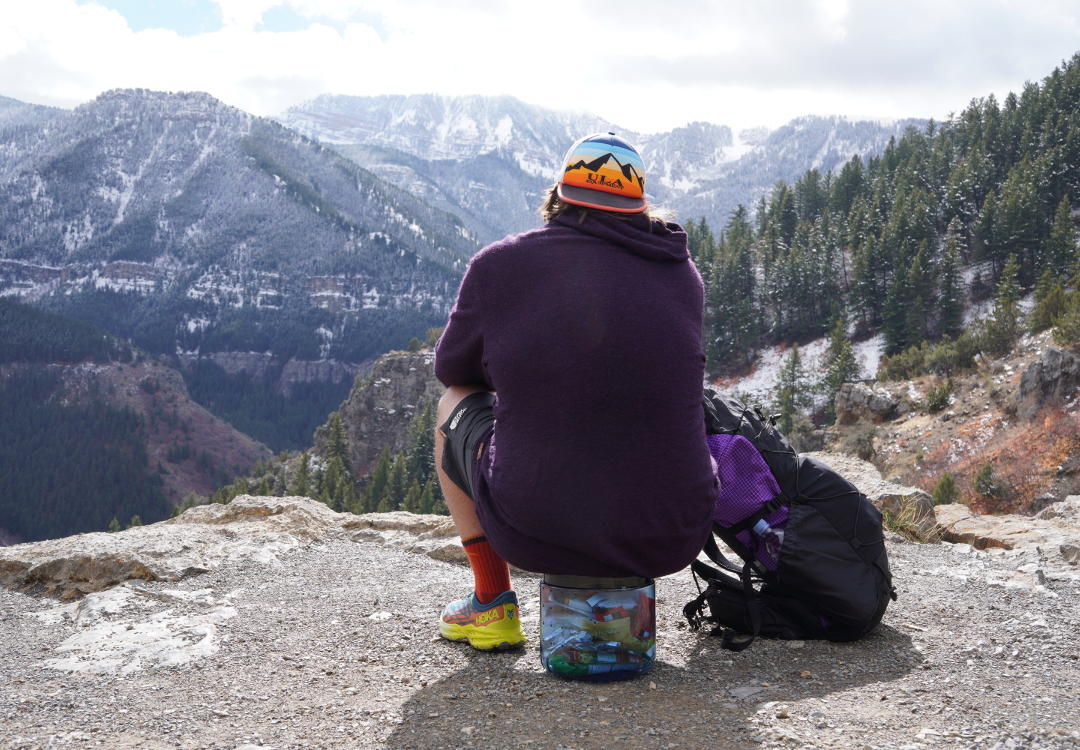
IN ADDITION TO BEAR SAFETY, A HARD-SIDED BEAR CAN MAKES A GREAT CAMP CHAIR…
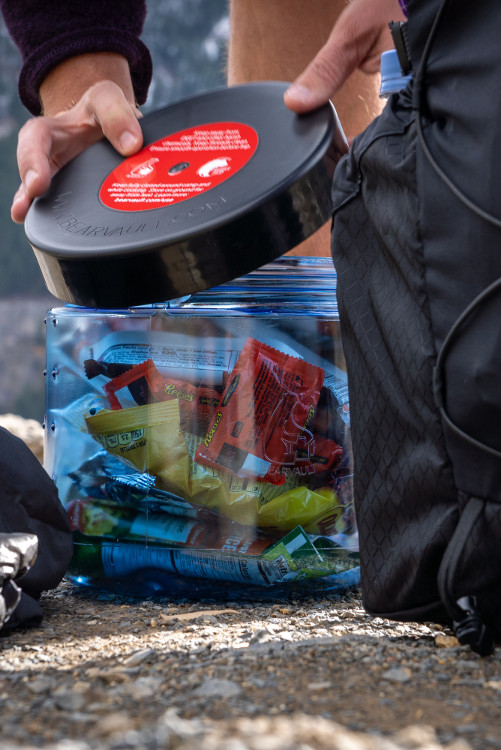
…AND KEEPS SNACKS FROM BEING CRUSHED.
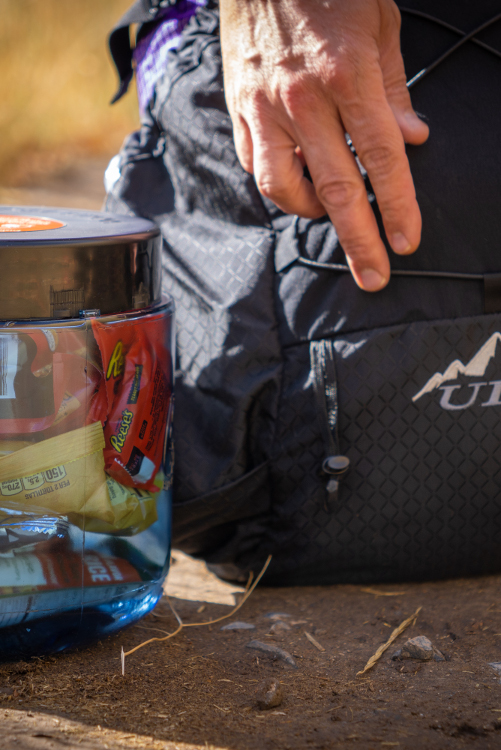
BEARVAULT NEXT TO A ULA CDT BACKPACK
AN INTERVIEW WITH BEARVAULT
We had the opportunity to chat with our friend Grant over at BearVault on some common questions we get from our customers and thought we’d go to the experts for the answers.
ULA: What are some common misconceptions about camping in bear country?
Grant: I’ll give you two common misconceptions. One common misconception is that a bear bell is a useful tool to alert bears to your presence and avoid provoking a defensive response from a startled bear. However, bear bells are just not loud enough to really alert a bear to your presence. The little jingle bells disrupt the peace enough as is, so bringing a full-size cowbell is sure to leave your ears ringing after a long day on the trail. The better option is to hike in a group and keep up a lively conversation when traveling through bear habitat, where your sight is limited and there may be bushes or blind corners that could lead to startling a bear. If you’re solo, don’t hesitate to bust out in song and dance (dance is optional) or clap when traveling through prime bear habitat. It’s better to get a few funny looks from other hikers than to startle a momma bear.
A second common misconception is that we can outwit a bear’s incredible sense of smell. BearVault put together an article diving into all the details on a bear’s smell capabilities if you want to dive into the details. But, to sum it up, bears have a real life superpower and it’s their noses. Many folks think they can place food in “smell proof” or “odor resistant” bags and then their food will be essentially invisible to the bears. While these products do reduce scent transmission, they are not perfect. Furthermore, when you seal a bag like this you still leave microscopic residue on the outside. Bears also know where you camp. Habituated bears don’t just stumble into camp by accident and find food. They know where the tent pads are and where they have found food before. Once a bear is in your camp and just feet from your food, no odor resistant bag will stop a bear from seeing and smelling your food. That’s why storing your food in a bear resistant canister is important.
ULA: Where can someone go to find a comprehensive list of state and natural areas that require food storage?
Grant: The legal documents that require using a bear canister are usually called food storage orders. They can be issued by the USFS, NPS, BLM, or state and local agencies. There are a lot of nuances between food storage orders. Some are broad and sweeping like the Yosemite National Park’s requirements whereas others are limited by season, area, or even things such as whether you are above or below treeline. This list changes often and the best course of action is to always double check with the area you are planning to travel to confirm canister requirements. BearVault does maintain a list of national parks with food storage regulations on our website. However, we ultimately encourage backpackers to consider carrying a canister whenever in bear habitat. The places with food storage orders have enacted those regulations after human bear conflicts reached a terrible level and bears have been euthanized and people often hurt. Keeping bears alive and staying safe starts with proactive work to prevent bears from becoming habituated in the first place. As a backpacker and steward of wild places, you have a responsibility to the bears around you.
ULA: How would someone determine which size canister they need?
Grant: Choosing the right size of canister for you is a very personal choice with a different answer for everyone. However, there are three primary variables. 1. How many days will you need to carry food without resupplying? 2. Do you eat like a mouse or a hungry bear? 3. How much space do you need for other scented items like toiletries, bug spray, and feminine hygiene products. Within these three variables there is a lot of nuance. For instance, if you carefully freeze drying your own food and pack it into every nook and cranny, you may be able to fit several days worth of food more than someone who resupplied at Dollar General. A good starting place is estimating 100 cubic inches per day. So for a seven day trip, the BV500 with 700 cubic inches would be the best bet. We prepared an article diving into the nuances of choosing a canister that you can check out.
ULA: What sizes does BearVault offer?
Grant: BearVault offers four sizes of bear canisters to ensure there is an option for every pack, every hiker, and every trip. These are the BV425-Sprint for 1-2 days, the BV450-Jaunt for 3-4 days, the BV475-Trek for 5-6 days, and the BV500-Journey for 7+ days.
ULA: Is the PCT the only long trail that has areas where bear canisters are required?
Grant: While the PCT is best known for its long stretches of canister requirements through the High Sierra, and more recently the Tahoe Basin and beyond, it is not the only long trail with a canister requirement. Most long trails have at least a portion of the trail in a required area. For instance, the CDT, where it enters Rocky Mountain National Park, requires canisters. On the AT, the forest service has several small hotspot areas where canisters are mandated, however, the Appalachian Trail Conservancy began officially recommending canisters for all trail users beginning in 2022. At the end of the day, nearly every long trail in the United States enters bear habitat and a canister is the best way to keep your adventure going and protect bears who call these ecosystems home.
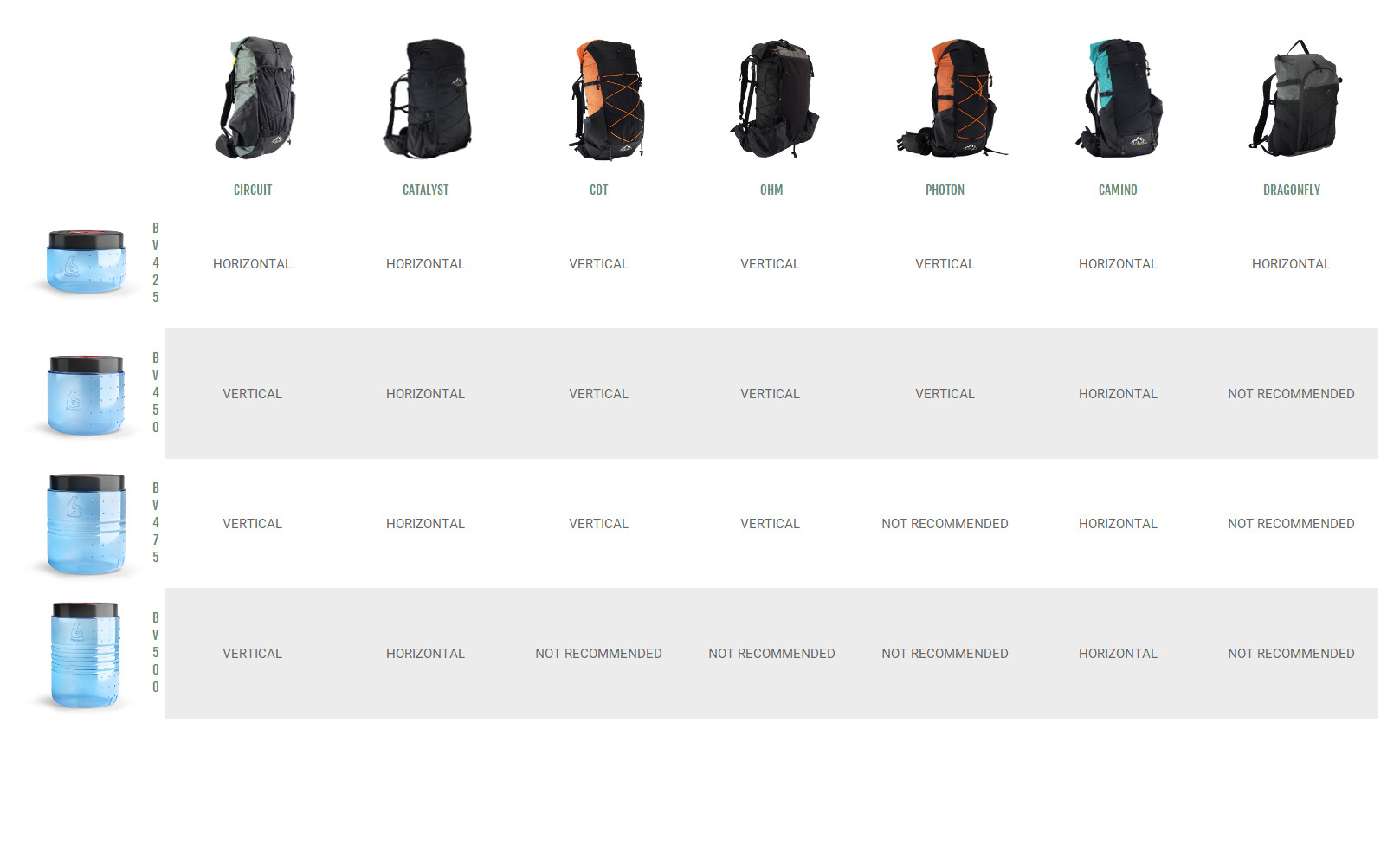


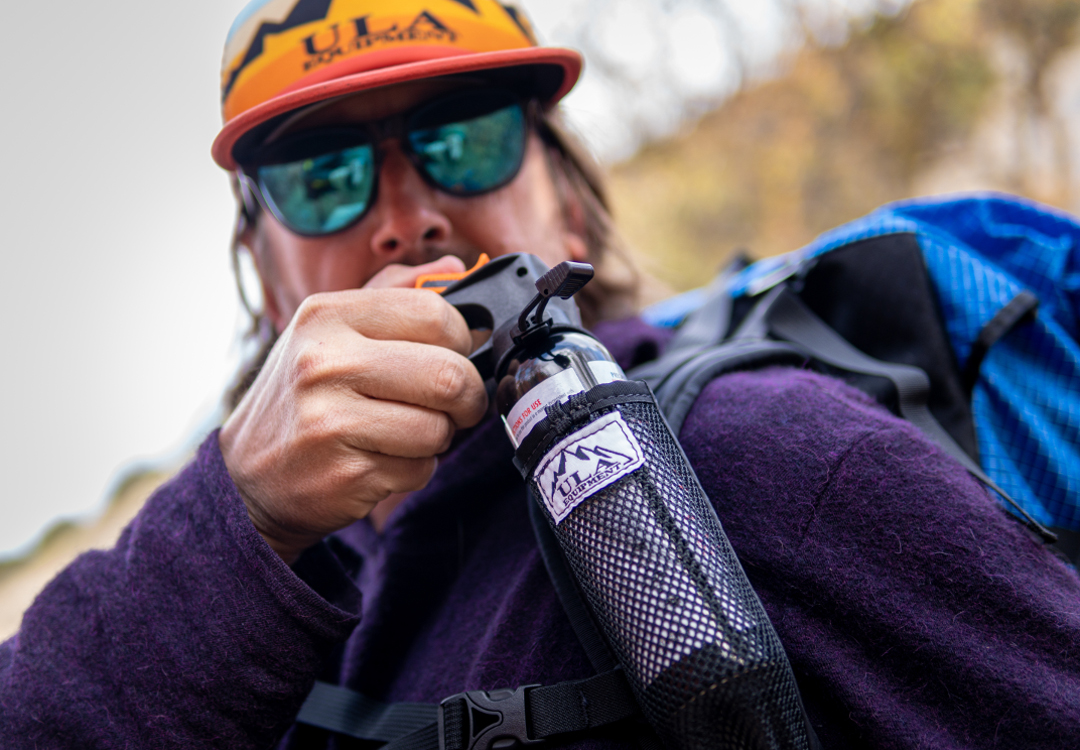
Hi, ULA. This is great info. Thanks!
I wish you would include at least the chart as a link on your website, perhaps as stand alone link at the top, linked on each pack grouping page, or perhaps as part of the pack sizing page.
I couldn’t find a mention of this article anywhere when I was looking for it on your website.
I have gone through many articles but none as clear and concise as this one. Additionally, given the great reviews as to the design and quality of the backpacks and after sales support I will be purchasing the Catalyst next week. I happily try and support great companies run by good, caring people.
I just want to point out that this article is one of the best I have ever read on this topic. I love my ULA Catalyst XPAC and my Bear Vaukt BV 500 canister. For many years I hung my food and lost it to an educated Black Bear at Hurricane Mountain Shelter on the Appalachian Trail near the Grayson Highlands area in Virginia on May 3, 2019. Since then I reluctantly because of the Wright penalty switched to the BV 500 and don’t regret it one bit. The weight penalty is far outweighed (no pun intended) by the fact that I no longer spend so much time at the end of a day looking for that “perfect” PCT hang limb. It makes a great stool and at the time to climb under my quilt I simply carry the can a safe distance from my tent site and sit it down. I take an extra precaution by attaching a small alarm to the cannister which screams loudly to up to 30 minutes if any thing moves my cannister pulling a pin and triggering the alarm, hopefully scaring the bear away or at least awakening me so I can go and box the Bear’s ears lol and take my food back. I’m NOT seriously suggesting trying to box a Bear’s ears but Bear Spray should do the trick if all else fails.
I have the Circuit pack and I can attest that I regularly carry my Garcia bear can in it horizontally at any position within the pack, but I usually put it at the top because it is most convenient to access it there. That can is 12″ tall. I also have the BV 450, which is significantly shorter and it (obviously) fits horizontally within the pack. The BV500 is almost 3/4″ taller than the Garcia and does NOT fit horizontally. I would say that if your bear can is 12″ or less it will fit in any position you want it to in the Circuit. I don’t know who put this chart together but it seems EXTREMELY conservative about fit orientation.
Good info about bear canisters and a bears’ sense of smell. The information about bear is not as good. All bear are really strong, run fast, and climb trees (even the griz). If you provoke a bear into charging, a griz might do a mock charge while a black bear probably won’t. Unprovoked attacks probably never happen; we just cannot identify the cause of the provocation.
If you stumble across a bear, get away from it as quickly and calmly as possible; your bear spray should be at the ready, but not aimed at the bear. There is no cause for concern until they start snarling at you. At that point, “getting away” changes to “escape” as quickly as possible without further riling the bear. At this point, I prefer to have my firearm in my shooting hand. Keep moving. With luck you will get out of the bears’ “personal space”.
During your first bear encounter you will be trying to suppress and control your panic. In your subsequent bear encounters moving out of the bears’ “intrusion zone” becomes second nature. Bear are magnificent animals. The best advice is to observe at a safe distance and realize that a “safe distance” is what the bear thinks it is.
I’ve had a number of bear encounters living in the Rocky Mountain forests of Montana, each was a thrilling experience. Only once did I kill the bear; looking back that is an unhappy memory.